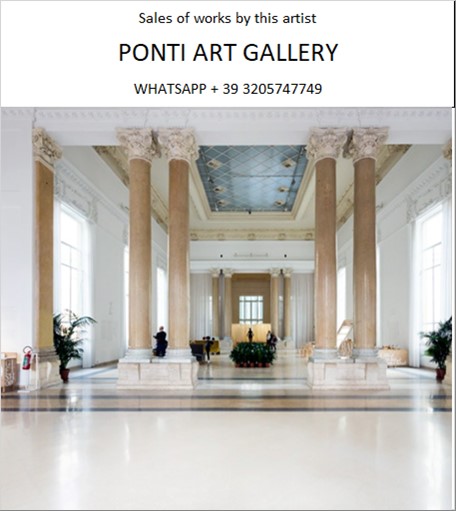Ponti Art Gallery is interested in buying and selling works
of art by this artist.

Nahil Bishara Biography
Nahil Bishara was a pioneering Palestinian artist whose life and work were deeply intertwined with the cultural and political landscapes of Jerusalem. Born in 1919, Bishara's artistic journey spanned much of the 20th century, a period marked by significant historical events that influenced her work and the broader context of Palestinian art.
Bishara's artistic contributions are particularly notable for their timing and context. During the early decades of the 20th century, as Palestine transitioned from Ottoman to British control, Western cultural influences began to permeate the region. This period saw the introduction of easel painting, a European practice that was adopted by local artists, including Bishara, who began to experiment with this new medium.
Despite the challenges faced by Palestinian artists during this era, including the escalating violence between Jewish and Arab forces that led to the displacement and death of many, Bishara managed to pursue her passion for art. She was one of the few women of her generation to attain a limited art education, which allowed her to develop her unique style and contribute to the nascent Palestinian art scene.
Bishara's work is characterized by its exploration of the Palestinian experience, often reflecting the resilience and endurance of her society. One of her key works, "Watermelon Farmer," painted in 1956, is a poignant example of this. The painting depicts a man pulling a cart of watermelons, a fruit that has since become a symbol of Palestinian resistance and solidarity. Created just eight years after the Nakba, the mass exodus of Palestinians from their homeland in 1948, the painting captures not only the hardships faced by Palestinian farmers but also the fertility of the Palestinian soil and the traditional attire of the time.
The significance of Bishara's work extends beyond its aesthetic value; it serves as a historical document that offers insight into the Palestinian way of life and the socio-political challenges of the era. Her granddaughter, Talia Bishara, has spoken about the importance of preserving and showcasing her grandmother's artwork, which she took with her when she left Jerusalem during the Second Intifada in 2002.
Bishara's legacy is celebrated in exhibitions and collections that aim to highlight Palestinian culture and history. Her work has been featured in significant exhibitions, such as "On This Land" at Alserkal Avenue, which was described as a triumph of Palestinian culture. The exhibition showcased a wide range of Palestinian art, from modern to contemporary works, and included other notable artists such as Ismail Shammout and Larissa Sansour.
Throughout her life, Bishara remained dedicated to her craft, leaving behind a body of work that continues to resonate with audiences today. Her paintings are not only visually striking but also carry the weight of the Palestinian narrative, embodying the collective memory and identity of her people.
Nahil Bishara passed away in 1997, but her influence on Palestinian art endures. Her works are preserved in various collections, including the Palestinian Museum's digital archive, which houses a collection of her pieces. These archives serve as a testament to her skill and dedication as an artist who navigated the complexities of her time with grace and resilience.
In summary, Nahil Bishara's biography is not just a chronicle of her life as an artist but also a reflection of the broader historical and cultural context in which she lived. Her artwork provides a window into the Palestinian experience, capturing the beauty, struggle, and spirit of a people through the lens of her unique artistic vision. As her works continue to be displayed and appreciated, Bishara's legacy as a pioneering figure in Palestinian art is cemented, ensuring that her contributions to the cultural heritage of her homeland are not forgotten.
Nahil Bishara Quotes and Sales
of Works
Ponti Art Gallery selects and deals with paintings by the
artist. Upon request, we provide free estimates and
evaluations, communicate prices, quotations, and current
market values.
If you are interested in BUYING or SELLING works by the
artist, contact us immediately.
If you wish to sell or receive an evaluation of the
works:
Send us a frontal photo of the painting, one of the back,
and one of the signature. Also, indicate the dimensions of
the work. Inform us about the purchase origin of the work
and any kind of available documentation (purchase
receipts, certificates of authenticity, publications). One
of our operators will respond to you on the same day. We
guarantee maximum confidentiality and extreme
professionalism.
If you wish to purchase works by the painter: Contact us
and let us know your request. We will inform you about the
available works. We also offer the possibility to
subscribe to our NEWSLETTER, through which you will be
informed at the beginning of each month about the latest
acquisitions of the art gallery.
You can send us pictures of the work:
